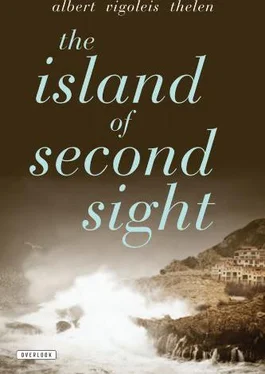Doubtless this was the same kind of mistake that almost led to the execution of the Admiral of the British Mediterranean Fleet when he was seen stepping out of a jolly boat on the sandy beach at Coll de Rebassa, all alone and dressed in a white civilian tropical suit. He wanted to take a swim, and that was prohibited under pain of death; every island beach was now a death zone. A swarm of kids, armed to the teeth, let out Indian war whoops and surrounded the man. The Admiral, of middling height and slim, his features the typical English hybrid of old salt and university scholar — we later made his acquaintance on board his ship — remained as composed as Karl May’s Old Shatterhand at the martyr’s stake. “What’s wrong, fellows?” he asked. But the fellows didn’t understand English, and weren’t in a joking mood. All of them had cocked their pistols, and now they were waiting to see who would take the first shot. It was a sure thing that this spy would have to be knocked off.
They couldn’t agree among them, and that is the only reason why the Admiral wasn’t summarily blasted into the sand. They got hold of a truck, and delivered their precious booty to Manacor. His Lordship offered no resistance. He couldn’t speak Spanish, and at Manacor they took him for a kook who was pretending to be the Admiral of the Mediterranean Fleet. They were used to cases like this one: even in peacetime, people on the island pretended to be all kinds of things they weren’t, and now in the midst of a war! This was a time when army generals were being canonized and worshiped. Even so, a few of the Manacor officers were taken aback. This kook’s behavior seemed to manifest a degree of hallucination unknown in Spain. They sent for an interpreter, who after a brief conversation advised them to send this Sir, unexecuted, to Palma. If it was found out that the guy was truly a nut case and hence a spy, he could still be shot in the head.
Meanwhile, in Palma a minor palace revolt had occurred involving rival factions of generals and commanders-in-chief of all nationalistic colorations, some of them the sworn enemies of some others. Carlists, Falangists, legionnaires, militiamen, paramilitaries, Guardia Civil: all of them were busy combing their brilliantine-soaked hair when news arrived that the Admiral of the British Mediterranean Fleet had been shot while swimming at Coll de Rebassa. The officers of the flagship London came to retrieve their boss, who was handed over to them unharmed. The Spaniards were happy to have avoided an international incident. That evening, I was later told by a reliable source who was also a direct participant, all the generals threw a huge party for their whores. The kids had their pistols taken away from them for 24 hours.
After leaving the British Consulate we went over to the French. Evacuation? Yes. Are you Swiss citizens? No. German? Yes. Two seconds later we were back out on the street. It couldn’t go any faster, since there were several doors between the street and the old Verdun warrior we had spoken with. Try explaining to a French consul that you are among the little band of degenerate Germans who aren’t out to lead their Fatherland to victory! But now, what reason would the German Consul have to refuse us, seeing that he considered me his best Führer . “Beatrice, will you come with me, or should I go alone?”
We went together. Beatrice had loaded her face-powder box with pepper, for all eventualities.
The German Consulate was now located in El Terreno, the fashionable residential section of the city, on the second floor of the Consul’s villa. There were no identifying signs outside. For fear of flying bricks, the Führer’s representative had unscrewed the plaque with the national insignia. All the other consulates had put up gigantic flags and painted their national colors on the roofs, a precaution during the continual aerial bombardments originating in Barcelona. Their automobiles, too, carried big fluttering flags, a spectacle outdone only by the adventurer from the Holy See Conte di Rossi, lord of the island, who mounted on his Bugatti a black flag with larger-than-life skull and crossbones.
So the Consul is getting the willies, I thought. He’s unsure of his position. My own courage, a bookworm’s courage, took heart at this idea. The stubborn fellow let us wait for about an hour.
In the course of my story I have been unable to resist the urge to throw out hints concerning the Consul’s crucial query about my having been shot. So now that the moment for that query has arrived, I fear I have squandered the narrative effect it might otherwise have. Instead of letting my recollections resemble a perpetuum mobile, I ought to have proceeded in strict chronological fashion with the aid of file cards to mark the temporal divisions. Every section should have been clearly delineated, all my sources neatly identified, the veracity of every assertion beyond question. Even memory lapses would be accounted for; that is how Count Kessler went about it, to cite just one example. I can depend on my Vigoleis only to the extent that he, the hindmost part of history, has no idea what his head has in mind — to quote Lichtenberg. But there are organisms that move more efficiently with their tails than with their heads. Like the whales, they can whip themselves right out of their milieu with a single whack of their flukes. When they plunge back into their element, it causes an earthquake. In this sense, we could say that the recollections of Vigoleis are being written with his tail. Count Kessler was one of the last remnants of a cerebral culture that is no longer with us. I regard it as one of the most vexing puzzles of my lifetime that he, such an intellectually superior individual, could ever don a uniform — and the Kaiser’s uniform at that. This very topic would have found its place in the third volume of his memoirs. It’s a shame that Kessler didn’t write his book backwards. When I once broached the subject with him, he reacted only with a pitying smile, as so often when I brought up matters or made suggestions that were foreign to his way of thinking. Did he think of me only as the idiot he first encountered when he found me stark naked under our Unlulunkulu? If so, then his polite silence was just the proper kind of behavior.
Yet if he had begun at the hind end of his story, he would have exposed himself to the danger of being shot by the Nazis immediately following the publication of Volume One, just as the Mexicans wanted his head because he, as the first European, reported in his 1898 Notes on Mexico on the satanic Ley fuga (“shot while trying to escape”) enforced by the dictator Porfirio Diaz. In Mexico he was placed on the Most Wanted list. It was terrible, the writer thought, to be shot while trying to escape. But in 1921 he saw fit to add a footnote to the new edition of his book, saying, “In Germany since the revolution we have unfortunately also had experience with the Ley fuga .” And something similar: the suppression of a conspiracy against Don Porfirio, discovered by the governor of Veracruz, who asked the dictator for instructions. Porfirio Diaz telegraphed back, “ Matan los todos! ”—Kill them all! That same night, Kessler writes, the governor arrested nine young men aged nineteen and twenty in their homes and ordered them shot under their own roofs. The bodies, with bullet holes in the back, were handed over to their parents. So what was happening on Mallorca, or for that matter in the Third Reich , was not so original after all. But perhaps it was more historical.
A stronger claim to imaginative planning, albeit one involving a leap backwards by two thousand years, could be made for the crucifixions that took place on Mallorca. There were rumors that people who didn’t believe in God, or who were branded as deniers of the Divinity (the Inquisition itself never created a reliable test; even Szondi is evasive on this point) were crucified by bands of extremely devout Falange fanatics, nailed to the famous 1000-year-old olive trees that were not only the pride of the island, but also a huge advertising success for the travel agencies. Gustave Doré himself was fascinated by the bizarre shapes of these olive trees. He used them as a model for the images of Hell in Dante’s Divine Comedy . In other words, these were very special trees, perfect for committing carnage in the name of religion. In earlier times trees were likewise used for massacres when not enough crosses could be built in time. So again: it’s all been done before. But is it really true? Were people actually nailed to the olive trees on Mallorca? I could find no eyewitnesses who could have confirmed this. I heard only whispered rumors.
Читать дальше












